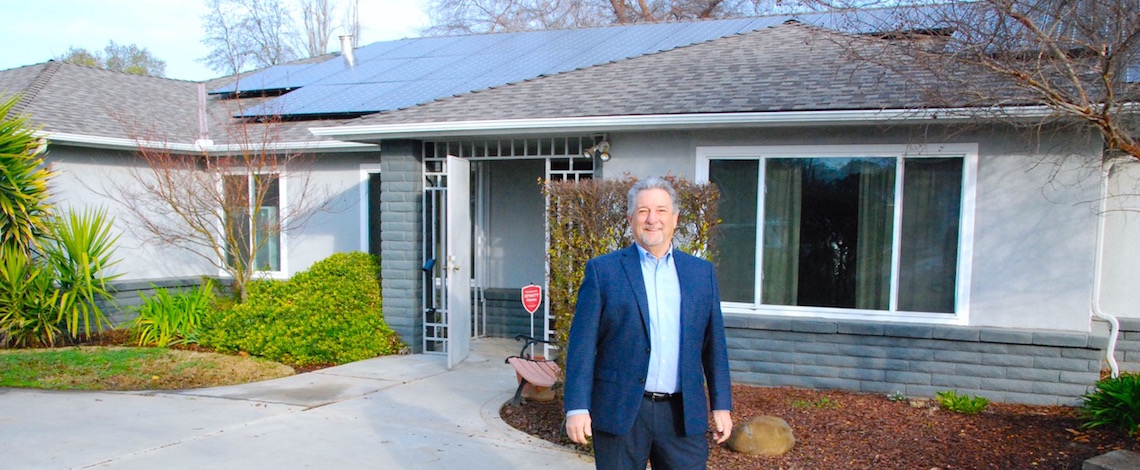
Fresno Realtor Don Scordino stands in front of a four-bedroom house in Madera Ranchos that his clients purchased in this February 2020 file photo. Photo by David Castellon
Written by Edward Smith
Looking back at the two months during shelter in place, the demand Realtor Don Scordino saw from homebuyers surprised him.
The nature of the disease and the response to it, coupled with market forces pre-dating Covid-19, kept housing prices afloat. Even as Americans experienced record unemployment and unprecedented uncertainty, lack of inventory and low interest rates incentivized buyers and sellers to make a deal.
March 16 — the date many shelter-in-place orders took effect — felt “like a ton of bricks” for Scordino, a broker associate with Realty Concepts and current president of the Fresno Association of Realtors.
In the four weeks after March 16, pending sales varied from 175-193 per week. After those weeks, those numbers shot up to 287-307.
“You can see the difference a month made,” Scordino said.
Sellers took their homes off of the market out of fear of inviting infection. But the drop off of available homes kept it a seller’s market.
One couple Scordino helped had to move to Arizona for a new job only a week after state officials closed down realty firms.
Scordino asked if there was any way for them to wait a couple months, but there was no way. Despite industries shutting down, their house closed with only a one-day delay.
In the South Valley, home prices for April were off 3.2% from the year before at a median price $252,750. Home sales dropped 12.3% and there was only 3.2 months of inventory, which Connie Kautz, president of the Tulare County Association of Realtors says was “low.”
The homes that sold the most were in the $250,000-$300,000 range, right near the median home price.
During shelter-in-place, regulations for Realtors changed so as to protect the health of homebuyers and sellers.
What was once a one-page form addressing home safety transformed into a 10-page form for Kautz, the buyers as well as vendors.
“It was a constant, continuing, changing environment trying to navigate through what we were supposed to do, but buyers needed to buy and sellers needed to sell,” Kautz said.
Banks also tightened lending standards, uncertain of how unemployment rates would affect borrowers.
From auto loans to mortgages, the number of banks hesitant to give out loans neared Great Recession levels, according to an article in Barron’s.
Many banks added risk overlays to credit applications, said John Vartanian, broker/owner with MAV Mortgage in Fresno, though changes were not across the board.
One thing banks wanted to see was extra proof of employment. In some cases, an older pay stub might not have been enough, said Vartanian. If the application period transitioned to the next month, it wasn’t uncommon for companies to request the most recent pay stub to ensure borrowers were still employed.
“Most of the overlays, while unpleasant, were good for the industry,” said Vartanian. “We don’t want to give someone a loan who just lost their job. That’s not good for anybody.”
The drop-off of home sellers created equilibrium in home prices, said Shane Steele, vice president of growth and marketing for Sundae, an off-market homebuyer based in San Francisco.
But once shelter-in-place orders are lifted, Steele fears a glut of houses may come on the market. And if banks continue to heavily scrutinize potential homebuyers, it could shrink demand and negatively impact housing prices.
Though regardless of what those standards are, said Vartanian, people are placing offers on homes.
The crisis is much different than 2008 — the last time Scordino was president of the Fresno Association of Realtors. He noted that while unemployment is higher now, high homeowner equity and low supply will bolster the housing economy.
High subprime mortgage rates ballooned and homebuyers did not have much equity in their homes in the aftermath of the Great Recession. In the fourth quarter of 2019, national homeowner equity increased 5.4% year-over-year to $489.4 billion. Negative equity declined 15% over the same time period.
Because of this, Scordino doesn’t think we’ll see panic buying like there was during the Great Recession.
“Someone who got a loan in the last five years probably doesn’t want to walk away from $50,000-100,000 in equity because there’s been that gentle rise in values, and with those good loans, there’s been a good drop in that loan balance,” Scordino said.






